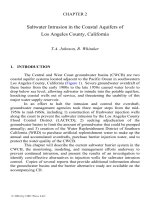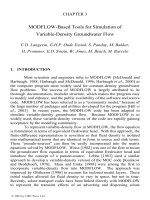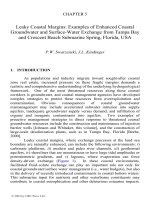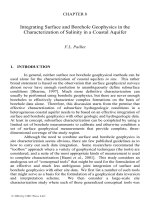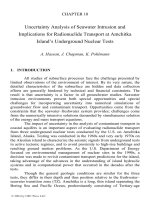Strategic management competitiveness globalization concepts and case 10e chapter 10
Bạn đang xem bản rút gọn của tài liệu. Xem và tải ngay bản đầy đủ của tài liệu tại đây (993.81 KB, 64 trang )
PART 3: STRATEGIC
ACTIONS:
STRATEGY
IMPLEMENTATION
CHAPTER 10
CORPORATE GOVERNANCE
Authored by:
Marta Szabo White, PhD.
Georgia State University
THE STRATEGIC MANAGEMENT PROCESS
©2013 Cengage Learning. All Rights Reserved. May not be copied, scanned, or duplicated, in whole or in part, except for use as permitted in a license distributed with a certain product or service or otherwise on a passwordprotected website for classroom use.
KNOWLEDGE OBJECTIVES
● Define corporate governance and explain why it is used to
monitor and control top-level managers’ decisions.
● Explain why ownership is largely separated from managerial
control in organizations.
● Define an agency relationship and managerial opportunism
and describe their strategic implications.
● Explain the use of three internal governance mechanisms to
monitor and control managers’ decisions.
©2013 Cengage Learning. All Rights Reserved. May not be copied, scanned, or duplicated, in whole or in part, except for use as permitted in a license distributed with a certain product or service or otherwise on a passwordprotected website for classroom use.
KNOWLEDGE OBJECTIVES
● Discuss the types of compensation top-level managers receive
and their effects on managerial decisions.
● Describe how the external corporate governance mechanism—
the market for corporate control—restrains top-level managers’
decisions.
● Discuss the nature and use of corporate governance in
international settings, especially in Germany, Japan, and China.
● Describe how corporate governance fosters the making of
ethical decisions by a firm’s top-level managers.
©2013 Cengage Learning. All Rights Reserved. May not be copied, scanned, or duplicated, in whole or in part, except for use as permitted in a license distributed with a certain product or service or otherwise on a passwordprotected website for classroom use.
OPENING CASE
CORPORATE GOVERANCE: WHAT IS ALL THE FUSS ABOUT?
■ Corporate governance can destroy or create value for a firm.
■ It is concerned with:
1. strengthening the effectiveness of a company’s board of directors
2. verifying the transparency of a firm’s operations
3. enhancing accountability to shareholders
4. incentivizing executives
5. maximizing value-creation for stakeholders and shareholders
©2013 Cengage Learning. All Rights Reserved. May not be copied, scanned, or duplicated, in whole or in part, except for use as permitted in a license distributed with a certain product or service or otherwise on a passwordprotected website for classroom use.
OPENING CASE
CORPORATE GOVERANCE: WHAT IS ALL THE FUSS ABOUT?
■ Given recent criticisms, boards’ actions in nations throughout the world are being more
carefully scrutinized and regulated.
■ In the U.S., that after being fired by their firm, a number of CEOs still remain as
members of other firms’ boards of directors, is drawing close attention.
■ Corporate governance is weak in many Chinese firms and there is concern about the
validity and reliability of some auditors’ work and the quality of companies’ financial
statements.
©2013 Cengage Learning. All Rights Reserved. May not be copied, scanned, or duplicated, in whole or in part, except for use as permitted in a license distributed with a certain product or service or otherwise on a passwordprotected website for classroom use.
OPENING CASE
CORPORATE GOVERANCE: WHAT IS ALL THE FUSS ABOUT?
■ The reason there is a “fuss” about corporate governance is that these activities are
critical to globally signaling transparency coupled with strategic competitiveness.
■ Corporate governance fundamentals:
Corporate Directors should:
● Focus on creating long-term value for shareholders
● Use performance-related pay to attract and retain senior management
● Exercise sound business judgment to evaluate opportunities and manage risk
● Communicate with key shareholders
©2013 Cengage Learning. All Rights Reserved. May not be copied, scanned, or duplicated, in whole or in part, except for use as permitted in a license distributed with a certain product or service or otherwise on a passwordprotected website for classroom use.
CORPORATE GOVERNANCE
Corporate governance: a set of mechanisms used
to manage the relationships (and conflicting interests)
among stakeholders, and to determine and control the
strategic direction and performance of organizations
(aligning strategic decisions with company values)
• When CEOs are motivated to act in the best interests of
the firm—particularly, the shareholders—the company’s
value should increase.
• Successfully dealing with this challenge is important, as
evidence suggests that corporate governance is critical
to firms’ success.
©2013 Cengage Learning. All Rights Reserved. May not be copied, scanned, or duplicated, in whole or in part, except for use as permitted in a license distributed with a certain product or service or otherwise on a passwordprotected website for classroom use.
CORPORATE GOVERNANCE
Corporate Governance Emphasis
Two reasons:
•
Apparent failure of corporate governance mechanisms to
adequately monitor and control top-level managers’ decisions
during recent times
•
Evidence that a well-functioning corporate governance and
control system can create a competitive advantage for an
individual firm
©2013 Cengage Learning. All Rights Reserved. May not be copied, scanned, or duplicated, in whole or in part, except for use as permitted in a license distributed with a certain product or service or otherwise on a passwordprotected website for classroom use.
CORPORATE GOVERNANCE
Corporate Governance Concern
• Effective corporate governance is of interest to nations as it
reflects societal standards:
• Firms’ shareholders are treated as key stakeholders as they
are the company’s legal owners
• Effective governance can lead to competitive advantage
• How nations choose to govern their corporations affects firms’
investment decisions; firms seek to invest in nations with
national governance standards that are acceptable
©2013 Cengage Learning. All Rights Reserved. May not be copied, scanned, or duplicated, in whole or in part, except for use as permitted in a license distributed with a certain product or service or otherwise on a passwordprotected website for classroom use.
SEPARATION OF OWNERSHIP AND MANAGERIAL
CONTROL
INTRODUCTION
• Historically, firms managed by founder-owners and
descendants
• Separation of ownership and managerial control allows
each group to focus on what it does best:
• Shareholders bear risk
• Managers formulate and implement strategy
©2013 Cengage Learning. All Rights Reserved. May not be copied, scanned, or duplicated, in whole or in part, except for use as permitted in a license distributed with a certain product or service or otherwise on a passwordprotected website for classroom use.
SEPARATION OF OWNERSHIP AND MANAGERIAL
CONTROL
INTRODUCTION (cont’d)
• Small firms’ managers are high percentage owners, which
implies less separation between ownership and management
control
• Family-owned businesses face two critical issues:
• As they grow, they may not have access to all needed
skills to manage the growing firm and maximize its
returns, so may need outsiders to improve management
• They may need to seek outside capital (whereby they give
up some ownership control)
©2013 Cengage Learning. All Rights Reserved. May not be copied, scanned, or duplicated, in whole or in part, except for use as permitted in a license distributed with a certain product or service or otherwise on a passwordprotected website for classroom use.
SEPARATION OF OWNERSHIP AND MANAGERIAL
CONTROL
Basis of the modern corporation:
•
Shareholders purchase stock,
becoming residual claimants
•
Shareholders reduce risk by holding
diversified portfolios
•
Shareholder value reflected in price
Modern public corporation form
leads to efficient specialization
of tasks:
•
Risk bearing by shareholders
•
Strategy development and
decision making by managers
of stock
•
Professional managers are contracted
to provide decision making
©2013 Cengage Learning. All Rights Reserved. May not be copied, scanned, or duplicated, in whole or in part, except for use as permitted in a license distributed with a certain product or service or otherwise on a passwordprotected website for classroom use.
SEPARATION OF OWNERSHIP AND MANAGERIAL
CONTROL
SHAREHOLDERS
•
•
•
Shareholders purchase stock
Entitled to income (residual returns)
Risk bearing by shareholders—firm’s expenses
may exceed revenues
•
Investment risk is managed through a
diversified investment portfolio
•
MANAGERS
Professional managers contracted to provide
decision making
•
Strategy development and decision making by
managers
©2013 Cengage Learning. All Rights Reserved. May not be copied, scanned, or duplicated, in whole or in part, except for use as permitted in a license distributed with a certain product or service or otherwise on a passwordprotected website for classroom use.
SEPARATION OF OWNERSHIP AND MANAGERIAL
CONTROL
FIGURE 10.1
An Agency Relationship
©2013 Cengage Learning. All Rights Reserved. May not be copied, scanned, or duplicated, in whole or in part, except for use as permitted in a license distributed with a certain product or service or otherwise on a passwordprotected website for classroom use.
SEPARATION OF OWNERSHIP AND MANAGERIAL
CONTROL
AGENCY RELATIONSHIPS
Managerial opportunism: seeking self-interest with guile (i.e.,
cunning or deceit)
• Opportunism: an attitude and set of behaviors
• Decisions in managers’ best interests, contrary to
shareholders’ best interests
• Decisions such as these prevent maximizing shareholder
wealth
• Principals establish governance and control mechanisms
to prevent agents from acting opportunistically.
©2013 Cengage Learning. All Rights Reserved. May not be copied, scanned, or duplicated, in whole or in part, except for use as permitted in a license distributed with a certain product or service or otherwise on a passwordprotected website for classroom use.
PRODUCT DIVERSIFICATION AS AN EXAMPLE OF AN
AGENCY PROBLEM
•Two benefits that accrue to top-level managers and not to
shareholders:
1. Increase in firm size: product diversification usually increases
the size of a firm; that size is positively related to executive
compensation
2. Firm portfolio diversification, which can reduce top executives’
employment risk (i.e., job loss, loss of compensation, and loss of
managerial reputation)
•Diversification reduces these risks because a firm and its
managers are less vulnerable to reductions in demand associated
with a single/limited number of businesses.
©2013 Cengage Learning. All Rights Reserved. May not be copied, scanned, or duplicated, in whole or in part, except for use as permitted in a license distributed with a certain product or service or otherwise on a passwordprotected website for classroom use.
FREE CASH FLOW AS AN EXAMPLE OF AN AGENCY
PROBLEM
Free cash flow: resources remaining after the firm has invested in all
projects that have positive net present values within its current
businesses
•Use of Free Cash Flows
■ Managers inclination to over-diversify and invest these funds in
additional product diversification
■ Shareholders prefer distribution as dividends, so they can control
how the cash is invested
©2013 Cengage Learning. All Rights Reserved. May not be copied, scanned, or duplicated, in whole or in part, except for use as permitted in a license distributed with a certain product or service or otherwise on a passwordprotected website for classroom use.
MANAGER AND SHAREHOLDER RISK AND
DIVERSIFICATION
FIGURE 10.2
Manager and Shareholder
Risk and Diversification
©2013 Cengage Learning. All Rights Reserved. May not be copied, scanned, or duplicated, in whole or in part, except for use as permitted in a license distributed with a certain product or service or otherwise on a passwordprotected website for classroom use.
MANAGER AND SHAREHOLDER RISK AND
DIVERSIFICATION
RISK
•
In general, shareholders prefer riskier strategies than managers
DIVERSIFICATION
•
Shareholders prefer more focused diversification
•
Managers prefer greater diversification, a level that maximizes firm
size and their compensation while
also reducing their employment
risk
•
However, their preference is that the firm’s diversification falls short
of where it increases their employment risk and reduces their
employment opportunities (e.g., acquisition target from poor
performance)
©2013 Cengage Learning. All Rights Reserved. May not be copied, scanned, or duplicated, in whole or in part, except for use as permitted in a license distributed with a certain product or service or otherwise on a passwordprotected website for classroom use.
AGENCY COSTS AND GOVERNANCE MECHANISMS
AGENCY COSTS: the sum of incentive costs, monitoring costs,
enforcement costs, and individual financial losses incurred
by principals, because governance mechanisms cannot
guarantee total compliance by the agent
● Principals may engage in monitoring behavior to assess the
activities and decisions of managers
● However, dispersed shareholding makes it difficult and
inefficient to monitor management’s behavior.
©2013 Cengage Learning. All Rights Reserved. May not be copied, scanned, or duplicated, in whole or in part, except for use as permitted in a license distributed with a certain product or service or otherwise on a passwordprotected website for classroom use.
AGENCY COSTS AND GOVERNANCE MECHANISMS
● Boards of Directors have a fiduciary duty to shareholders to
monitor management
● However, Boards of Directors are often accused of being lax in
performing this function
● Costs associated with agency relationships, and effective
governance mechanisms should be employed to improve
managerial decision making and strategic effectiveness
● In response, U.S. Congress enacted:
▪ Sarbanes-Oxley (SOX) Act in 2002
▪ Dodd-Frank Wall Street Reform and Consumer
Protection
Act (Dodd-Frank) in mid-2010
©2013 Cengage Learning. All Rights Reserved. May not be copied, scanned, or duplicated, in whole or in part, except for use as permitted in a license distributed with a certain product or service or otherwise on a passwordprotected website for classroom use.
AGENCY PROBLEMS GOVERNANCE MECHANISMS
RE
NCY
AGE
IP S
NSH
O
I
T
LA
AGENCY
PROBLEMS
GOVERNANCE
MECHANISMS
©2013 Cengage Learning. All Rights Reserved. May not be copied, scanned, or duplicated, in whole or in part, except for use as permitted in a license distributed with a certain product or service or otherwise on a passwordprotected website for classroom use.
AGENCY COSTS AND GOVERNANCE MECHANISMS
All of the following are consequences of the Sarbanes-Oxley Act:
● Decrease in foreign firms listing on U.S. stock exchanges at the
same time as listing on foreign exchanges increased
● Internal auditing scrutiny has improved and there is greater
trust in financial reporting
● Section 404 creates excessive costs for firms
Determining governance practices that strike a balance between
protecting stakeholders’ interests and allowing firms to
implement strategies with some degree of risk is difficult
©2013 Cengage Learning. All Rights Reserved. May not be copied, scanned, or duplicated, in whole or in part, except for use as permitted in a license distributed with a certain product or service or otherwise on a passwordprotected website for classroom use.
GOVERNANCE MECHANISMS
Three internal governance mechanisms and a single external one are
used in the modern corporation.
The three internal governance mechanisms are:
1. Ownership Concentration, represented by types of shareholders
and their different incentives to monitor managers
2. Board of Directors
3. Executive Compensation
The external corporate governance mechanism is:
4. Market for Corporate Control
This market is a set of potential owners seeking to acquire undervalued
firms and earn above-average returns on their investments by replacing
ineffective top-level management teams.
©2013 Cengage Learning. All Rights Reserved. May not be copied, scanned, or duplicated, in whole or in part, except for use as permitted in a license distributed with a certain product or service or otherwise on a passwordprotected website for classroom use.


